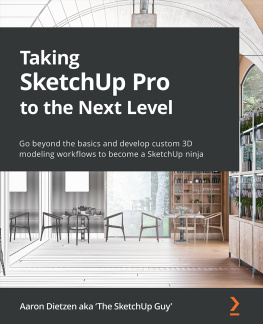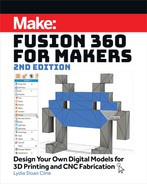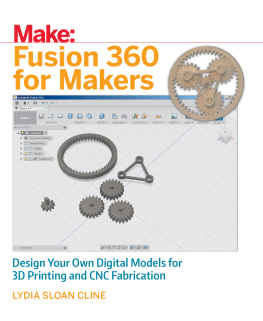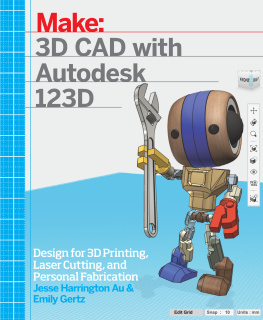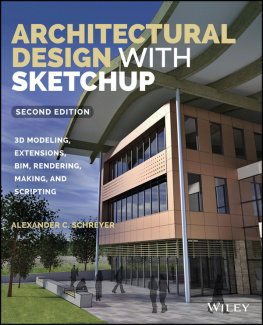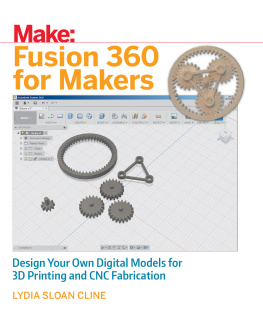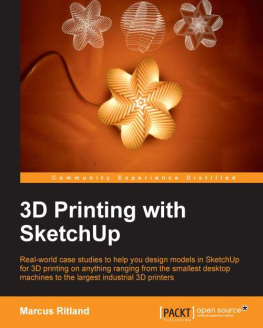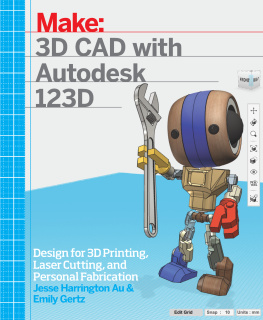About the Author
Lydia Sloan Cline teaches drafting, digital modeling, and 3D printing classes at Johnson County Community College in Overland Park, Kansas. She works for architecture firms, judges competitive technology events, and became a SketchUp fan after using its Push/Pull tool for the first time. Lydia is also the author of 3D Printing with Autodesk 123D, Tinkercad, and MakerBot (published by McGraw-Hill Education) and other books.
Copyright 2016 by McGraw-Hill Education. All rights reserved. Printed in the United States of America. Except as permitted under the United States Copyright Act of 1976, no part of this publication may be reproduced or distributed in any form or by any means, or stored in a data base or retrieval system, without the prior written permission of the publisher.
ISBN: 978-0-07184310-2
MHID: 0-07-184310-8
The material in this eBook also appears in the print version of this title: ISBN: 978-0-07-184241-9, MHID: 0-07-184241-1.
eBook conversion by codeMantra
Version 1.0
All trademarks are trademarks of their respective owners. Rather than put a trademark symbol after every occurrence of a trademarked name, we use names in an editorial fashion only, and to the benefit of the trademark owner, with no intention of infringement of the trademark. Where such designations appear in this book, they have been printed with initial caps.
McGraw-Hill Education eBooks are available at special quantity discounts to use as premiums and sales promotions or for use in corporate training programs. To contact a representative, please visit the Contact Us page at www.mhprofessional.com.
McGraw-Hill Education, the McGraw-Hill Education logo, TAB, and related trade dress are trademarks or registered trademarks of McGraw-Hill Education and/or its affiliates in the United States and other countries and may not be used without written permission. All other trademarks are the property of their respective owners. McGraw-Hill Education is not associated with any product or vendor mentioned in this book.
Information contained in this work has been obtained by McGraw-Hill Education from sources believed to be reliable. However, neither McGraw-Hill Education nor its authors guarantee the accuracy or completeness of any information published herein, and neither McGraw-Hill Education nor its authors shall be responsible for any errors, omissions, or damages arising out of use of this information. This work is published with the understanding that McGraw-Hill Education and its authors are supplying information but are not attempting to render engineering or other professional services. If such services are required, the assistance of an appropriate professional should be sought.
TERMS OF USE
This is a copyrighted work and McGraw-Hill Education and its licensors reserve all rights in and to the work. Use of this work is subject to these terms. Except as permitted under the Copyright Act of 1976 and the right to store and retrieve one copy of the work, you may not decompile, disassemble, reverse engineer, reproduce, modify, create derivative works based upon, transmit, distribute, disseminate, sell, publish or sublicense the work or any part of it without McGraw-Hill Educations prior consent. You may use the work for your own noncommercial and personal use; any other use of the work is strictly prohibited. Your right to use the work may be terminated if you fail to comply with these terms.
THE WORK IS PROVIDED AS IS. McGRAW-HILL EDUCATION AND ITS LICENSORS MAKE NO GUARANTEES OR WARRANTIES AS TO THE ACCURACY, ADEQUACY OR COMPLETENESS OF OR RESULTS TO BE OBTAINED FROM USING THE WORK, INCLUDING ANY INFORMATION THAT CAN BE ACCESSED THROUGH THE WORK VIA HYPERLINK OR OTHERWISE, AND EXPRESSLY DISCLAIM ANY WARRANTY, EXPRESS OR IMPLIED, INCLUDING BUT NOT LIMITED TO IMPLIED WARRANTIES OF MERCHANTABILITY OR FITNESS FOR A PARTICULAR PURPOSE. McGraw-Hill Education and its licensors do not warrant or guarantee that the functions contained in the work will meet your requirements or that its operation will be uninterrupted or error free. Neither McGraw-Hill Education nor its licensors shall be liable to you or anyone else for any inaccuracy, error or omission, regardless of cause, in the work or for any damages resulting therefrom. McGraw-Hill Education has no responsibility for the content of any information accessed through the work. Under no circumstances shall McGraw-Hill Education and/or its licensors be liable for any indirect, incidental, special, punitive, consequential or similar damages that result from the use of or inability to use the work, even if any of them has been advised of the possibility of such damages. This limitation of liability shall apply to any claim or cause whatsoever whether such claim or cause arises in contract, tort or otherwise.
To Makers all over the world and the companies that support their efforts.
And a big thanks to
Roger, Amber, and Christie, who indulge and contribute to my own Maker efforts.
Contents
Preface
THE PAST DECADE has seen tremendous interest and possibilities in 3D printing and CNC fabrication. Novices and professionals are using them to make their lives and jobs more rewarding and productive. When these technologies are combined with websites such as Quirky, Kickstarter, Prosper, Etsy, and Shapeways, and social media outlets such as Twitter and Facebook, people are empowered to turn hobbies into businesses. 3D printing, CNC fabrication, and those who do them are loudly ringing in the New Industrial Revolution.
3D printing in particular is becoming part of our nations education, and to be competitive in school and work most people will eventually require knowledge of it. Electronics, toy, food, automotive, and construction companies are finding innovative ways to use this technology. The military is experimenting with it. 3D printing solutions are currently being utilized in everything from housing to human body parts. But even so, current 3D printers are comparable to the dot-matrix printers of the early 1980s. Eventually theyll enable solutions we can barely imagine right now.
Creating, manufacturing, and advertising are becoming democratized because of affordable tools and low startup costs. No matter what your age or background, you can participate, because the barriers are low. The same way that software and laser printers let anyone publish from their kitchen table, and WordPress and a website let anyone have a nice storefront, free modeling software, cheap printers, and community Maker spaces enable anyone to put out a product. Mass manufacturing isnt going away, but micromanufacturing and justin-time manufacturing that cater to niche and customization markets also will find a bigger place (). So will the Makers who learn these technologies.

Figure 1 A page at shapeways.com, where Makers print and sell their creations.
Websites such as the Trimble 3D Warehouse, where designs are freely shared, let the worlds citizens tinker with, customize, and improve each others work in the spirit of open source. Maker Faires let them show off what theyve done. The nascent Maker movement might counter cheap overseas labor and bring manufacturing back to the United States. Teachers, students, homeschoolers, dreamers, entrepreneurs, and you, since youre holding this book, are making this happen! You may already have some concrete ideas about what youd like to do.


